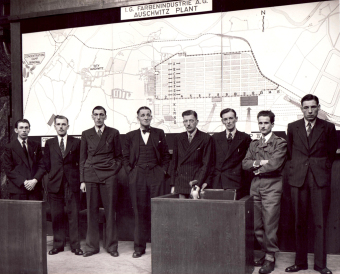British Prisoners of War as Witnesses in the I.G. Farben Trial

© National Archives, Washington, DC
In the I.G. Farben Trial in Nuremberg (Case VI), the investigators based their preferral of charges partly on the affidavits of 19 former British POWs from the E715 prisoner of war camp in Auschwitz and a former POW from the camp in Heydebreck, William Allen. The affidavits were made in July 1947, mostly in Great Britain, to which the former POWs had returned. Only Eric James Doyle and Reginald Austin Hartland gave their statements for the first time in Nuremberg in November 1947. Allen’s affidavit was withdrawn from the documentary evidence on January 27, 1948, as the prosecution deemed sufficient the materials it had presented by that date, including many affidavits from witnesses whom, unlike Allen, it also had been possible to examine before the court.
Seven of the former British POWs appeared as prosecution witnesses in Nuremberg in mid-November 1947. Among them were Charles Joseph Coward and Robert William Ferris, both of whom later gave testimony in the Wollheim suit as well.
At the center of the affidavits are the prisoners of the Buna/Monowitz concentration camp, whom the British POWs encountered at the I.G. Auschwitz construction site. The British witnesses tell of the maltreatment and murder of the prisoners by the master craftsmen, Kapos, and SS, and of the poor food and thin clothing provided to the prisoner population. Some of the witnesses report that they helped prisoners by giving them food. All indicate that they were aware of the gas chambers in Birkenau, and some tell how I.G. Farben employees approved of the gassing of Jews.
The seven witness examinations are characterized most notably by the defense counsel’s strategy of casting doubt on the statements of the witnesses during cross-examination or asking detailed questions based on a map of I.G. Farben’s plant and camp complex in Auschwitz. For the most part, this examination elicits almost no additional information, merely a reiteration of what the affidavits already contained. In some places, however, the examinations, especially of Robert William Ferris and Reginald Austin Hartland, yield further detailed glimpses of the conditions at the I.G. Farben construction site, the work of both the British POWs and the concentration camp prisoners, their contacts with each other, and the dealings of the German master craftsmen and SS men with the prisoners.
(MN; transl. KL)
















